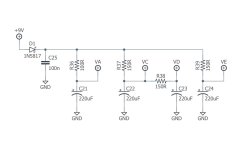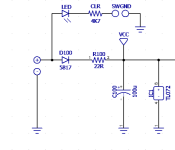Hey all,
So I am thinking about doing some layouts with 1/8w resistors as I am only using 50x50 boards and space can be tight.
I’m bewildered though…
Everything I read says that the lowest ohm resistor you can use is around 650r if running 9v and connected to the power rail. 1/4w resistors half.
So riddle me this and educate me please. I’m a bit of a Cornish nut. Here is a snippet of a typical Cornish power section. It’s designed for 1/4w but every resistor here is half or under the resistance Ohms law says it should be.
What am I not understand ???

Thanks in advance people of the guitar pedal world !
So I am thinking about doing some layouts with 1/8w resistors as I am only using 50x50 boards and space can be tight.
I’m bewildered though…
Everything I read says that the lowest ohm resistor you can use is around 650r if running 9v and connected to the power rail. 1/4w resistors half.
So riddle me this and educate me please. I’m a bit of a Cornish nut. Here is a snippet of a typical Cornish power section. It’s designed for 1/4w but every resistor here is half or under the resistance Ohms law says it should be.
What am I not understand ???

Thanks in advance people of the guitar pedal world !


